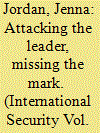| Srl | Item |
| 1 |
ID:
131111


|
|
|
|
|
| Publication |
2014.
|
| Summary/Abstract |
Leadership targeting has become a key feature of counterterrorism policy. Both academics and policymakers have argued that the removal of leaders is an effective strategy in combating terrorism. Leadership decapitation is not always successful, however, and existing empirical work does not account for this variability. A theory of organizational resilience explains why decapitation results in the decline of some terrorist organizations and the survival of others. Organizational resilience is dependent on two variables: bureaucratization and communal support. Older and larger organizations tend to develop bureaucratic features, facilitating a clear succession process and increasing their stability and ability to withstand attacks on their leadership. Communal support plays an important role in providing the resources necessary for terrorist groups to function and survive. Religious and separatist groups typically enjoy a high degree of support from the communities in which they operate, and thus access to critical resources. Application of this theoretical model to the case of al-Qaida reveals that Osama bin Laden's death and the subsequent targeting of other high-level al-Qaida operatives are unlikely to produce significant organizational decline.
|
|
|
|
|
|
|
|
|
|
|
|
|
|
|
|
| 2 |
ID:
150978


|
|
|
|
|
| Summary/Abstract |
In the last few years, the Islamic State, or IS, has become a central focus of public debates about U.S. national security. A May 2016 poll by the Pew Research Center reported that 80 percent of Americans think IS poses the greatest international threat to the United States.11. “Public Uncertain, Divided Over America's Place in the World,” Pew Research Center, May 5, 2016.
|
|
|
|
|
|
|
|
|
|
|
|
|
|
|
|
| 3 |
ID:
092890


|
|
|
|
|
| Publication |
2009.
|
| Summary/Abstract |
Leadership targeting has become a key feature of current counterterrorism policies. Both academics and policy makers have argued that the removal of leaders is an effective strategy in combating terrorism. However, leadership decapitation is not always successful, and existing empirical work is insufficient to account for this variability. As a result, this project answers three primary questions: (1) Under what conditions does leadership decapitation result in the dissolution of a terrorist organization?; (2) Does leadership decapitation increase the likelihood of organizational collapse beyond the baseline rate of collapse for groups over time?; and (3) In cases where decapitation does not result in group collapse, to what extent does it result in organizational degradation and hinder a group's ability to carry about terrorist attacks? I develop a dataset of 298 incidents of leadership targeting from 1945-2004 in order to determine whether and when decapitation is effective. First, I identify the conditions under which decapitation has been successful in bringing about organizational decline. The data show that a group's age, size, and type are critical in identifying when decapitation will cause the cessation of terrorist activity. As an organization grows in size and age, it is much more likely to withstand the removal of its leadership. Organizational type is also significant in understanding the susceptibility of an organization to decapitation. Ideological organizations are most likely to experience a cessation of activity following the removal of leader, while religious organizations are highly resistant to leadership decapitation.
|
|
|
|
|
|
|
|
|
|
|
|
|
|
|
|